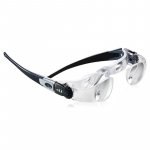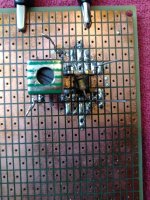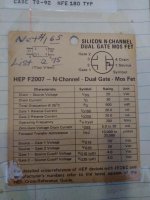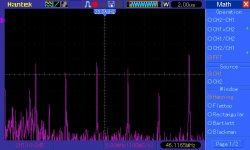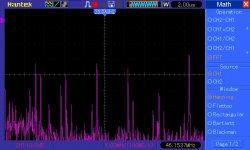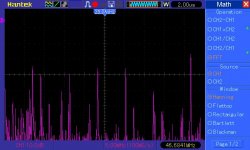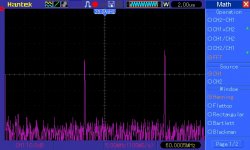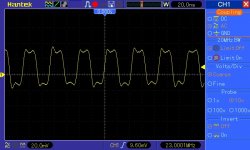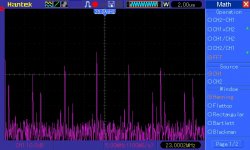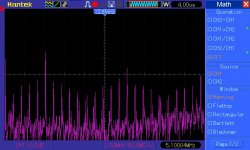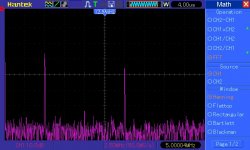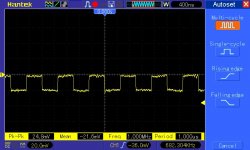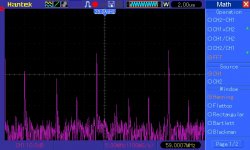What I ended up with is called binocular microscope. Something like this. Binocular Microscope | eBay
and with 2x binocular loupes for bigger stuff.
So if you hands are still steady then use liquid flux and, unfortunately expensive, decent soldering station with proper tips.
Cheers
and with 2x binocular loupes for bigger stuff.
So if you hands are still steady then use liquid flux and, unfortunately expensive, decent soldering station with proper tips.
Cheers
I have observed that fire depts, forest service and police type agencies are maintaining the old FM licenses and equipment. I asked local IT/radio fire dept what's up with that.
It's because the trunking systems not really very reliable in many situations and lives have been lost.
It's because the trunking systems not really very reliable in many situations and lives have been lost.
Interesting audio clips of various modulation and encryption schemes. Some sound like noise.
W2SJW - Radio Sounds
W2SJW - Radio Sounds
In Britain our fire brigades used a VHF AM system, presumably for the same reason that aircraft use AM. Now they use a digital system, the same as the other services. As we know, it is always a good idea to put all your eggs in the same basket.
... they wind up using their mobile phones, quite a lot, as TETRA is so good... Or so I'm told!
Good luck!
Unfortunately, I have the attention span of a Gnat, so I just moved on, maybe temporarily. Maybe not.
That cheap HP chip is rated for +14 dbm on it's RF input, so I burned through a few ( four, actually ) of those just fooling around with them, and my impression is that it seemed to make a pretty good low lever TX mixer - right up to the point they quit.
I was going to try one of those AD831 boards in the TX spot, but got sidetracked by this guy. Who remembers the HEP line? I think this was Ma Batwings equivalent to the 40673. Except for the flying 100K, all 1206 and 0805 parts.
What can I say? I like dual gate MOSFETS. If that AD831 didn't work so darn well, I'd have stuck a DG MOSFET in it's place by now .....
Win W5JAG
Attachments
I'm surprised we still have 6 meters.
My grandfather used to have this ancient TV set that had channel 1 on it's radio style variable tuner. It went from 1 to 6, then you flipped the switch to get 7 through 13. There was no UHF when this thing was made. Considering that it received the upper VHF channels in roughly the right spot on the dial, it must have been made between 1946 and 1948 when channel 1 vanished, and part of it became the 6 meter ham band. At roughly the same time the FM broadcast band moved and the 30 to 50 MHz land mobile allocations appeared. It was about the only option for public safety at the time, but today the 30 to 50 MHz band is virtually vacant in most large cities today.
Public safety is predominantly VHF at 136 to 174 MHz, UHF at 450 to 512 MHz, 700 at 764 to 806 MHz and 800 at 806 to 870 MHz. Chunks of spectrum in the middle of these public safety bands are allocated to other services including ham radio.....that's why the Baofengs can be called "ham radios."
The 30 to 50 MHz land mobile spectrum requires rather large antennas to be efficient. This makes walkie talkies and covert radio equipment rather difficult. It is still used for secondary communications on police, fire and forestry vehicles due to the lower frequencies ability to penetrate dense foliage.
The 30 to 50 MHz spectrum isn't "wall to wall" carriers like VHF, UHF and 800 is, and the lower VHF TV channels (54 to 88 MHz) are nearly vacant in many locations, so I doubt that there are too many people looking to take 6 meters.
fire depts, forest service and police type agencies are maintaining the old FM licenses.....because the trunking systems not really very reliable
There is a lot more to it than that, and much of it is political. From 1984 to 1994 I worked in the trunking development group at Motorola and spent quite a bit of time out in the field solving issues with the then new trunking systems. There were some real issues, with all aspects of the early installations, but the new stuff works good......when it is set up, managed, provisioned, and operated correctly.
When 911 happened and it became evident that everybody had different non compatible radio systems and couldn't talk to each other, a bunch of federal money became available to fix this. Now 15 years later things are still messed up.
It seems that in many areas the "fix" was implemented by taking all the radio systems for small town police, fire, and other public safety out of their hands and putting them ALL on a county wide, or even state wide Mega Trunking System. Of course this puts many small town radio and IT guys out of a job, and it wasn't always implemented correctly either. It took a couple of years for Broward County Florida's (where I lived and the Motorola plant was) system to work right. Still today many of the small (and not so small) towns have their own radio systems. They either refused to join the Mega System or have their radios programmed for both systems. Two cops on stakeout to bust some drug dealers don't need or want to be on the mega system for every scanner radio in the county to hear.....
various modulation and encryption schemes. Some sound like noise.
Motorola has some serious digital voice encryption systems......the bad guys know what they sound like, and if they can hear it on a scanner listening on the direct frequency (repeater input) they vanish. Hence a mode on "type 2 trunking" systems where the radio frequency hops, every time you push the PTT, the radio is on a different frequency. A county wide trunking system can have 40 or more frequencies.
We sold them at Olsons when I worked there. Hobby, Experimenter, Professional......they were Batwings way of competing with RCA's SK series, and Sylvania's ECG parts, which became NTE parts. I used some HEP parts when I worked at Olsons, but they often cost twice as much as the part that they replaced.Who remembers the HEP line?
The Go To dual gate fet in my TV descrambler days was the Motorola 3N211. Who knows if you can get anything like it today, but they were free by filling out a sample request when I worked there.
GE had a hobby / service line as well, but, for the life of me, I can't think of the prefix. Every once in a while when I am going through a sack of parts in the cabinet of sacks, I'll run across an SK chip I got for some reason.
I can't remember what I bought last month, but I am near certain these ancient HEP semi's came from Smith's Two Way Radio in Fayetteville. AR, when I was in college. They were likely long discontinued even by that time.
Win W5JAG
I can't remember what I bought last month, but I am near certain these ancient HEP semi's came from Smith's Two Way Radio in Fayetteville. AR, when I was in college. They were likely long discontinued even by that time.
Win W5JAG
...the Motorola 3N211. Who knows if you can get anything like it today ...
I have some NXP SMD dual gates that are only about forty cents / per at Mouser, and was going to use one of those, but I used this HEP guy instead, because the weird package is the same spacing as DIP. So it "fit" where I was using the SA612, HP whatever, etc. I just reflowed the soldered up pads, and dropped new parts in ...
Win W5JAG
That Dentron brick was designed for milliwatt level drive, but I fully expect the output transistors to be dead shorts, and likely not an economically feasible repair unless I can scrounge up some transistors. It may be possible to take some output from the drivers, if they are any good, but that would still leave me with a giant brick, for just a few watts. I'm not sure it is even worth fooling with at this point, other than to gut it for whatever parts may be good ...
To hedge my bets, I ordered one of these two watt "class A linear" amps from eBay, which also should not need much in the way of drive.
42dB 1Mhz-800Mhz 433Mhz HF FM transmission RF UVF FM Linear power Amplifier 2W | eBay
If it works somewhat as advertised, i.e., it really is a linear amp, and 40 db of gain at 50 MHz, I should be able to drive it more or less right from the TX mixer. If I can get to one or two watts output without a bunch of other drama, I have stuff on hand that should get me to fifty ish watts.
I'm somewhat ethically troubled by all this. Prefab RX mixer board, prefab LO, prefab IF board stolen from a junker, prefab PA - not that much DIY here ....
Win W5JAG
To hedge my bets, I ordered one of these two watt "class A linear" amps from eBay, which also should not need much in the way of drive.
42dB 1Mhz-800Mhz 433Mhz HF FM transmission RF UVF FM Linear power Amplifier 2W | eBay
If it works somewhat as advertised, i.e., it really is a linear amp, and 40 db of gain at 50 MHz, I should be able to drive it more or less right from the TX mixer. If I can get to one or two watts output without a bunch of other drama, I have stuff on hand that should get me to fifty ish watts.
I'm somewhat ethically troubled by all this. Prefab RX mixer board, prefab LO, prefab IF board stolen from a junker, prefab PA - not that much DIY here ....
Win W5JAG
Ask some of the guy's transmitting on those frequencies from the upper floors of tower blocks in Birmingham, I've missed them since I moved..........
Haha yes they do that in Coventry as well....
Hills FM IIRC haha
Has anyone ever used a MC1496 balanced modulator? Want one? Get 'em while you can ...
I have some DIP parts of these somewhere, and more recently I ordered some SOIC because the thru-hole parts were obsolete. There's other parts that can be used (after redoing the circuit for them), but clicking "Substitutes/Please click here" in the email I got didn't bring anything up.
Quoting this little retrospective from 2012: "The MC1496 is now horribly obsolete, ..."
MC1496 (MC1496)
Then there's this undated webpage [my comment in brackets]:
"In the history of semiconductors there are very few integrated circuits that are still in production after more than 40 years from their initial release. MC1496 is [make that WAS] one of them. ON Semi and JRC they are still producing the chip, ..."
1496 Hardware Defined Radio - Compact SSB/CW Transceiver for 20m
I looked, Digikey does show the JRC chip, but it's a non-stock, 12-week leadtime item.
Scrolling down to the schematic, that dual-gate Q1, BR964, is also obsolete. I didn't check the other parts they listed for Q1.
So here's today's email from Digikey:
"You have purchased the following part number from Digi-Key within the last two years. The manufacturer has announced an update to the part status.
Part Affected
Manufacturer ON SEMICONDUCTOR
Description IC MODULATOR/DEMODULATOR 14-SOIC
Manufacturer Part Number MC1496DG
Digi-Key Part Number MC1496DGOS-ND
Status End Of Life
Last Time Buy Date 04/18/2019
Substitutes Please click here
End of Life
End of Life (EOL) refers to the planned demise of a product. Reasons for this may include market demands, technological innovation, and development driving changes in the product. The EOL process consists of a series of technical milestones and activities that, once completed, make a product obsolete."
I have some DIP parts of these somewhere, and more recently I ordered some SOIC because the thru-hole parts were obsolete. There's other parts that can be used (after redoing the circuit for them), but clicking "Substitutes/Please click here" in the email I got didn't bring anything up.
Quoting this little retrospective from 2012: "The MC1496 is now horribly obsolete, ..."
MC1496 (MC1496)
Then there's this undated webpage [my comment in brackets]:
"In the history of semiconductors there are very few integrated circuits that are still in production after more than 40 years from their initial release. MC1496 is [make that WAS] one of them. ON Semi and JRC they are still producing the chip, ..."
1496 Hardware Defined Radio - Compact SSB/CW Transceiver for 20m
I looked, Digikey does show the JRC chip, but it's a non-stock, 12-week leadtime item.
Scrolling down to the schematic, that dual-gate Q1, BR964, is also obsolete. I didn't check the other parts they listed for Q1.
So here's today's email from Digikey:
"You have purchased the following part number from Digi-Key within the last two years. The manufacturer has announced an update to the part status.
Part Affected
Manufacturer ON SEMICONDUCTOR
Description IC MODULATOR/DEMODULATOR 14-SOIC
Manufacturer Part Number MC1496DG
Digi-Key Part Number MC1496DGOS-ND
Status End Of Life
Last Time Buy Date 04/18/2019
Substitutes Please click here
End of Life
End of Life (EOL) refers to the planned demise of a product. Reasons for this may include market demands, technological innovation, and development driving changes in the product. The EOL process consists of a series of technical milestones and activities that, once completed, make a product obsolete."
Mouser has over 10K of the high temp SOIC MC1496's and 2K of the std temp flavors. They are 84 and 82 cents each. I used these in several radio projects years ago.
MC1496BDR2G ON Semiconductor | Mouser
MC1496BDR2G ON Semiconductor | Mouser
... Has anyone ever used a MC1496 balanced modulator? Want one? Get 'em while you can ...
I used one as the balanced modulator in my first SSB rig. They require a lot of external resistors which makes them harder to use, but allows the user to control the balance. They work well. I have a dozen or so in DIP and the can, including the LM1596H hi temp variant.
First pic is the 23 MHz ish LO output. The spurs are actual spurs of the Si5351 whatever, they are NOT being generated in the MOSFET. Note the nasty spur ( well, they're all nasty ) at 15 MHz
Second pic is with a 9 MHz 200 mv signal injected into the mixer. The desired 14 Mhz output is visible next to the 15 MHz spur, about 6 db down.
Third pic is the LO being moved about 200 KHz, the spur has moved 1 MHz - it's a traveler.
So, too close to filter out, moves around so can't be trapped.
I have smacked the Si5351 whatever with a hammer. A big one. I derived great satisfaction from this - pretty much ALL the satisfaction I have ever got from the device.
I have the QRP Labs Si5351 device that I will try. I also have an Adafruit Si5351 breakout to play with. Unfortunately this is a busy time of year for me, and I will probably do a staycation at the lake starting later in the month.
Win W5JAG
Attachments
I built out the QRP Labs Si5351 VFO, but forgot to take any pictures of it. There are plenty on their website
It differs materially from the other device in that it has more sophisticated control firmware, 2 fixed outputs plus a tunable output, a 27 MHz reference instead of 25 MHz, and modular construction.
In terms of cleanliness, it's a little better than the other one, but not that much. The synthesis architecture of these devices is just apparently really dirty.
The screenshots pretty much speak for themselves. Multiples of 5 MHz are quite clean. Deviating from a multiple of 5 MHz … all bets are off.
5 MHz would be one LO choice for a 14 MHz rig with a 9 MHz IF. Look at what a difference 100 KHz makes.
23 MHz would be the high side injection.
59 MHz would be high side injection for a 45 MHz first IF, or a 6 meter single conversion rig with high side injection and a 9 MHz IF.
I have not turned on any of the fixed outputs to see what effect, if any, it has on the tunable LO
I guess with a balanced TX mixer to null out the LO port, and enough bandpass filtering, it can possibly be made to have a clean enough output to be legal. The way I read the rules, the TX has to meet the spurious emission requirement at the antenna port on the radio - even though a mobile antenna would tune very sharply and cut way down on the transmitted junk, you can't count that ...
Win W5JAG
It differs materially from the other device in that it has more sophisticated control firmware, 2 fixed outputs plus a tunable output, a 27 MHz reference instead of 25 MHz, and modular construction.
In terms of cleanliness, it's a little better than the other one, but not that much. The synthesis architecture of these devices is just apparently really dirty.
The screenshots pretty much speak for themselves. Multiples of 5 MHz are quite clean. Deviating from a multiple of 5 MHz … all bets are off.
5 MHz would be one LO choice for a 14 MHz rig with a 9 MHz IF. Look at what a difference 100 KHz makes.
23 MHz would be the high side injection.
59 MHz would be high side injection for a 45 MHz first IF, or a 6 meter single conversion rig with high side injection and a 9 MHz IF.
I have not turned on any of the fixed outputs to see what effect, if any, it has on the tunable LO
I guess with a balanced TX mixer to null out the LO port, and enough bandpass filtering, it can possibly be made to have a clean enough output to be legal. The way I read the rules, the TX has to meet the spurious emission requirement at the antenna port on the radio - even though a mobile antenna would tune very sharply and cut way down on the transmitted junk, you can't count that ...
Win W5JAG
Attachments
I built out the QRP Labs Si5351 VFO, but forgot to take any pictures of it. There are plenty on their website
It differs materially from the other device in that it has more sophisticated control firmware, 2 fixed outputs plus a tunable output, a 27 MHz reference instead of 25 MHz, and modular construction.
In terms of cleanliness, it's a little better than the other one, but not that much. The synthesis architecture of these devices is just apparently really dirty.
The screenshots pretty much speak for themselves. Multiples of 5 MHz are quite clean. Deviating from a multiple of 5 MHz … all bets are off.
It's surely the "synthesis architecture" - the way these things work. To get any "off-count" frequency, they alternate between divide-by-N and divide-by-N+1, and make these both the "same" period by switching in and out short delay networks. There's only so much fixing you can do to make a smooth turning shaft using gears with teeth that don't mesh.
Calling this a "DDS" (that I saw earlier in the thread, and saw elsewhere online where other hams were using these chips) gives a real DDS a bad name.
It's hard to imagine "enough bandpass filtering" for good results. You won't be making far-out-of-band stuff so much (since that's easier to filter out) and you could filter out enough near the carrier to maybe make it legal, but I can imagine people saying "Ya know, no matter how close you are to the repeater or on simplex, your signal never sounds like full quieting, there's always some noise or rumble or something in there."I guess with a balanced TX mixer to null out the LO port, and enough bandpass filtering, it can possibly be made to have a clean enough output to be legal. The way I read the rules, the TX has to meet the spurious emission requirement at the antenna port on the radio - even though a mobile antenna would tune very sharply and cut way down on the transmitted junk, you can't count that ...
Win W5JAG
It seems to me the way to make a "real" clean and digitally tunable signal is to use a nice clean clock running a real DDS and then use a frequency multiplier(s) to get up to the band you want.
Not really sure how I want to proceed at the moment. The Si5351 is pretty d**n dirty, that's for sure, at least the two I've gotten my hands on.
It seems pretty popular, somebody has solved the problem, or there are a lot of dirty TX's in homebrew rigs. Hopefully they are low power ...
I have an older VFO - that is a real DDS AFAIK ( AD8950, I think ) - that I did find after a mighty search, and I thought I might take a look at the output spectrum on it. It would have to be mixed to an appropriate LO frequency.
I've also thought about a VCO or LC oscillator, and something along the lines of a huff and puff frequency stabilizer to keep it in place. I have a bunch of MC1648P VCO chips I never got around to using. Interestingly, the web page with the most information on huff and puffs looks to be the personal web page of the fellow that runs QRP Labs. There are one or two commercial kit huff and puffs that are not too expensive.
I have an older PLL VFO, but it is setup for 10.7 MHz IF's, and I'm not sure how easy it would be to change that at this point, or to change the SG-9 to 10.7 MHz. On the SG-9, it might be as easy as changing the IF transformers, filter, and BFO, except that last IF has a tap for the AGC. It may just be a center tap on the primary, or it may be at a different point ...
Ever seen a BFO crystal for a 10.7 MHz IF? Me, neither, so the filter would have to pass the desired sideband so a 10.7 MHz crystal could be the BFO. I have a KVG filter that might do the job, no real way to know until I can sweep it.
This is not a good time of year for me, so I don't expect much progress until after the first of the year.
I'm certainly open to suggestions in the meantime. Maybe SDR really is the way to go.
Win W5JAG
It seems pretty popular, somebody has solved the problem, or there are a lot of dirty TX's in homebrew rigs. Hopefully they are low power ...
I have an older VFO - that is a real DDS AFAIK ( AD8950, I think ) - that I did find after a mighty search, and I thought I might take a look at the output spectrum on it. It would have to be mixed to an appropriate LO frequency.
I've also thought about a VCO or LC oscillator, and something along the lines of a huff and puff frequency stabilizer to keep it in place. I have a bunch of MC1648P VCO chips I never got around to using. Interestingly, the web page with the most information on huff and puffs looks to be the personal web page of the fellow that runs QRP Labs. There are one or two commercial kit huff and puffs that are not too expensive.
I have an older PLL VFO, but it is setup for 10.7 MHz IF's, and I'm not sure how easy it would be to change that at this point, or to change the SG-9 to 10.7 MHz. On the SG-9, it might be as easy as changing the IF transformers, filter, and BFO, except that last IF has a tap for the AGC. It may just be a center tap on the primary, or it may be at a different point ...
Ever seen a BFO crystal for a 10.7 MHz IF? Me, neither, so the filter would have to pass the desired sideband so a 10.7 MHz crystal could be the BFO. I have a KVG filter that might do the job, no real way to know until I can sweep it.
This is not a good time of year for me, so I don't expect much progress until after the first of the year.
I'm certainly open to suggestions in the meantime. Maybe SDR really is the way to go.
Win W5JAG
Not really sure how I want to proceed at the moment. ...
Plan A is to pull the unbalanced mixer, and replace it with something balanced. If the LO gets nulled by X amount, I don't see why the spurs would not also null by X amount, and then look at the output spectrum and see where I'm at. Maybe it will be usable. Maybe not.
The logical choice, of what I have in stock, is MC / LM 1496 or 1596. They can be externally balanced by hand for best null, and, as best I recall, null really deep. I think I was seeing - 50 db on the balanced modulator in my first rig, and that was on perfboard.
I also might give one of those AD831 mixer boards a shot at this function - it seems to do a good job on RX. For something cheap and prefab off eBay, I'm actually pretty impressed with this board / part.
However, to maximize the pain, um, learning curve, I might also try out some singly balanced circuits to see what they can do in terms of LO null.
Plan B is one of the cheap AD9850 DDS boards all over eBay. These only go to 50 MHz or so, so useless for stand alone double conversion to a low VHF IF ( the reason why I rejected them this time last year in favor of the Si5351 ), but since I have determined this first iteration will be single conversion down, it is a non issue at the moment. These all look to be a clone / knock off of a design published by an Indian ham, whose call escapes me at the moment, but a few minutes with google turns it up. I have already ordered one of these.
Plan C is my old DDS - which uses an older AD9835 chip, which will have to be mixed to whatever LO frequency I want. Crystals are in my Mouser shopping cart for my next order. The 1980's all over again ...
I've thought about converting the SG-9 to 10.7 MHz to use my existing PLL VFO, and decided there are just too many unknowns to attempt this, and I don't want to bother with mixing it, when I have the AD9835 thing a ma jig. The transformers on the SG-9 have internal resonating caps, so I can't easily resonate them to a different frequency. I don't know anything about the winding ratios, so replacing them with 10.7 MHz xfmrs may or may not keep the existing gain structure; it just looks like too big a can of worms to open, even assuming I can overcome the filter / BFO issues.
Win W5JAG
- Home
- Member Areas
- The Lounge
- No RF gear here?
